A basement is a part of the foundation protruding above the ground, which is exposed to atmospheric precipitation and other negative external factors. Different materials are used to protect this part of the structure. Plastering a plinth is one of the most common and simplest finishing methods. All work can be done independently. The main thing is to choose the right mixture and observe the technology of its application.
Requirements for plastering the plinth
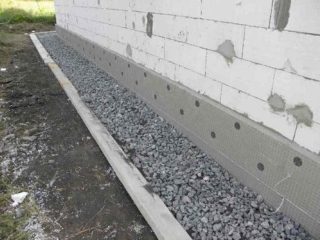
For long-term operation of basement plaster, you need to choose a material that will meet certain requirements:
- Moisture resistance. This part of the foundation is most susceptible to the influence of water or snow. It is also affected by aggressive substances.
- Strength. The finish must protect the base from mechanical damage.
- Resistance to negative temperatures.
- Immunity to direct sunlight.
- Inert to chemical and biological factors.
- Easy to clean.
- Environmental Safety.
- Monolithicity.
- Durability, ease of repair.
The base / plinth is an overground part and should be visually attractive, therefore decorative finishing is important.
Choosing a solution for plastering
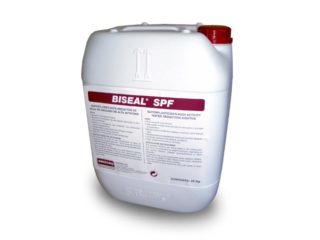
Plastering the basement is a responsible procedure, so you need to choose a mixture taking into account the conditions of its operation. Usually the solution is prepared using cement and sand. To improve the properties of the material, plasticizers are introduced into its composition. It is better to choose a mixture with waterproofing elements.
You also need to pay attention to the ratio of the components in the solution. The optimal indicators are 1 part of cement (M400) and 3 parts of sand. The sand should be cleaned as much as possible from impurities. The amount of water is selected in each case individually.
There are also polymer plaster compounds that have improved properties in relation to homemade mortars.
Materials used

To plaster the basement of the house from the outside, you need to choose the appropriate type of mixture. Depending on the binder component, the following types of ready-to-use materials are distinguished:
- Mineral. These types of finishes include white cement. These plasters are cheap. They are used to level the surface. The disadvantage of the mixture is its low elasticity, which contributes to the rapid cracking of the layer. This material is characterized by a poor color scheme. The solution consumption ranges from 1.5 to 4.5 kg / sq.
- Acrylic. Products have a high degree of elasticity, so they practically do not crack. The mixtures are resistant to mechanical damage, do not fade in the sun. The layer has a weak vapor permeability. For 1 sq. m. area leaves 1.5-4 kg of solution.
- Silicate. These materials are based on liquid potassium glass. The layer is good for steam, does not lend itself to mechanical damage. A plus is a wide range of colors. The coating is resistant to biological factors. The disadvantage of compositions with liquid glass is the complexity of its application.In addition, the solution must be handled carefully, because it contains alkali. Consumption is about 2-4 kg per 1 sq. M.
- Polysilicate. The composition of such mixtures contains silicate resin. They are UV resistant. They are characterized by ease of application, safety. This type of mortar is not highly resistant to mold.
- Silicone. The most durable and resistant to mechanical damage materials. They are characterized by a wide range of colors, good vapor permeability. Material consumption ranges from 1.7–2.4 kg / m. sq.
The choice depends on the specific operating conditions. Decorative plaster options contain additional components: marble or granite chips, as well as other substances that improve the appearance of the base.
For plastering the base, you can prepare a homemade mortar. It will be much cheaper than ready-mix. Sand and cement required. All components must have an appropriate expiration date and be clean. For stirring, purified cold water is needed. PVA glue or detergent can be used as a plasticizer. When preparing a solution, a combination of components must be observed.
Stages of plastering the basement
Base / plinth mosaic plaster or other types of materials are applied after preliminary preparation of the base. The works are carried out in a certain sequence.
Preparation
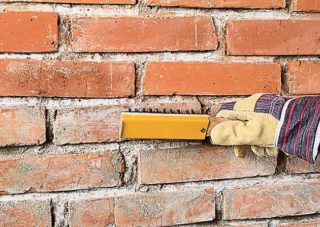
Initially, the surface of the base must be carefully examined for cracking, weak areas. If a brick is used to make the basement of the house, the seams must be thoroughly cleaned. If there are cracks in the monolithic tape, they must be widened and deepened. Weak points are removed. A stiff metal brush is used to clean these areas.
After all imperfections have been removed, the surface of the base is treated with a deep penetration primer. Sometimes it is required to apply several layers of solution. The treatment will increase the adhesion of the surface to the plaster. All seams, chips are smeared with liquid more thoroughly.
If it is not possible to use a primer, a liquid cement mortar is used instead. It is applied to the surface by spraying. A paint brush is used for work. Further work is carried out after the solution has dried.
Finishing work
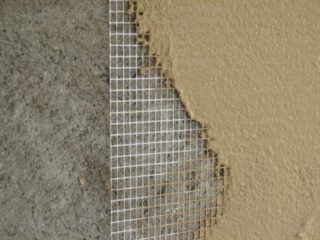
The procedure for finishing the basement:
- Fastening a metal reinforcing mesh. Thanks to this, the layer is durable. Dowels with wide heads are used to fix the product. For each square meter, 20 fasteners are required.
- Installation of lighthouses. To install the first elements, 30 cm recede from the corners and screws are screwed in. Then they are connected with a thread. During work, you need to use the building level. A distance of 2 cm is observed between the thread and the wall. A metal profile is set according to the markings. The distance between the elements is 1.5 m. For fixing the lighthouses, a cement mortar is used, which must harden.
- Plastering. The solution is thrown between the beacons. To align it, use the rule that is carried out along the beacons. The action is repeated until the plastering process is completed.
- Elimination of beacons. This must be done as soon as the plaster has set. The remaining indentations are filled with the mixture. The surface of the finish is treated with a float.
If metal beacons are left behind, rust stains may appear on the wall over time.
Wet facade technology
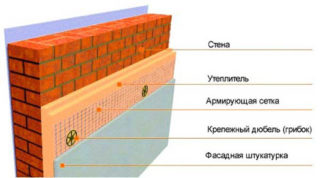
Recently, craftsmen have been using the "wet facade" technology more often. A special mixture is required, which contains water. The work is carried out in the following sequence:
- Cleaning the base, applying primer to the surface.
- Installation of a basement profile.It is screwed at a distance of 30 cm from the ground line using self-tapping screws.
- Fastening the heat-insulating material. For this, tile glue is used. It will take several days to dry. For additional fixing of the insulation, dowels are used.
- Reinforcement of the material with a special adhesive, installation of the mesh.
- Decorative plastering of the surface.
For work, use a frost-resistant mixture.
Stone technology
Stone plaster is a decorative finish that is available for DIY. For work, a solution of cement and sand of a thick consistency is required. The thickness of the layer ranges from 0.5-3 cm. It all depends on the type of the simulated stone.
There are several ways of making the finish: using a stencil, cutting seams. In the first case, the template is applied to the applied plaster and tapped on it. The seams are then slightly widened. Cutting requires a sharp tool to shape the elements. After drying, the finish is primed and painted.
Advantages and disadvantages of plaster base
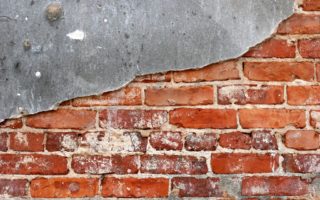
The advantage of this type of finish is high reliability and financial efficiency, since the layer can be operated for a long time without additional repairs. No expensive equipment is required to carry out the work. You can apply the mixture yourself. Most mixes are affordable. If maintenance is necessary, it is not difficult to carry out it.
The strength of the plaster layer is lower than that of stone or tiles. The downside is the low level of thermal insulation.
Plastering the base helps to protect the base from the influence of negative external factors. In addition, the decorative layer makes the house complete and enhances its appearance.








